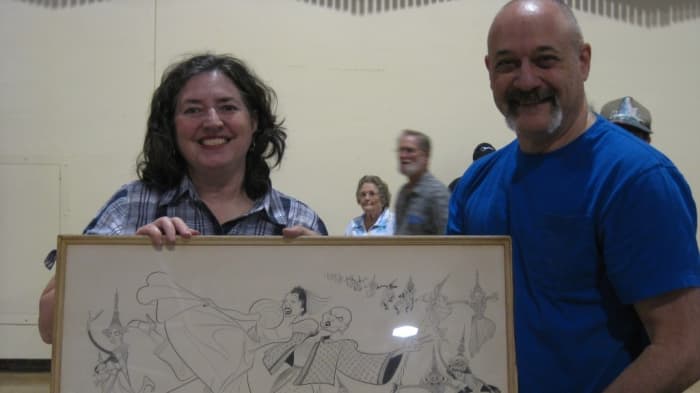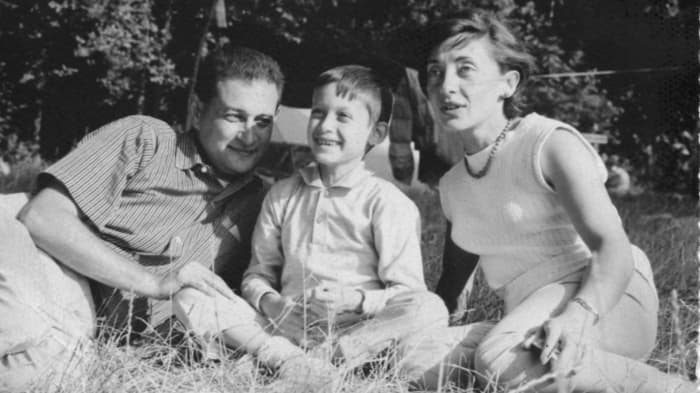One summer day in the early 1960s, Michel Kleinbaum, a diamond setter who lived in New York City, paid a visit to his favorite thrift store near where he worked in Manhattan. It’s the place that he found all sorts of items of interest — he was always on the hunt for anything bird-related, since he was an inveterate bird-watcher.
But on this occasion, he came upon a drawing depicting the cast of the original 1951 production of “The King and I.” It was by none other Al Hirschfeld, the caricaturist whose work showcasing figures in the entertainment world was regularly featured in The New York Times.
Kleinbaum, who regularly attended Broadway shows in New York with his wife, knew he had to have it. The price? A mere $12 — a bargain even by the standards of the day. Even better, the store was having a summer sale, so he nabbed it for $9.75.
Roughly 60 years later, the drawing has come to light once again. Kleinbaum’s son, Georges, has decided to sell it now that both his father and mother have passed away.
But Georges will be getting a fair bit more than $9.75. The work is expected to go for $50,000, according to the Al Hirschfeld Foundation, which is handling the sale.
“I was not expecting that!” says Georges, 67, who lives in Salem, Ore.
The story is reminiscent of some other recent tales of thrift-store finds — say, the Picasso poster acquired for $14 that later sold for $7,000. But in this case, it also speaks to the growing interest in Hirschfeld (1903-2003), the remarkable illustrator whose career spanned more than 75 years.
With his simple, elegant pen strokes, Hirschfeld captured just about anyone who appeared on a Broadway stage — or any stage (or film and television set) for that matter. His list of subjects ranged from Ethel Merman to Liza Minnelli, the Marx Brothers to the Beatles — and in many cases, he made several drawings of the same people over the years.
Al Hirschfeld at work in his studio in 1999
Alan Behr/courtesy of the Al Hirschfeld Foundation
These days, Hirschfeld originals can sell for up to $60,000 — and limited-edition lithographs for $20,000, according to David Leopold, creative director of the Hirschfeld Foundation. Meagan McMillan, a Hirschfeld expert who works for Heritage Auctions, a leading auction house that specializes in art and collectibles, says she could see prices reaching six figures in a few years.
“There is a lot of room to grow,” says McMillan, who is currently helping coordinate an online auction of Hirschfeld drawings, with the proceeds to benefit the Broadway Cares/Equity Fights AIDS organization and the Hirschfeld Foundation.
Hirschfeld’s work is also the subject of an exhibition, “The American Theatre as seen by Hirschfeld,” that will open Nov. 15 at New York City’s new Museum of Broadway. There’s a book with the same title also coming out this month.
The Hirschfeld “King and I” drawing, depicting Yul Brynner and other members of the original cast, will be featured in the exhibition. When Georges Kleinbaum first reached out to David Leopold of the Hirschfeld Foundation about it, Leopold assumed it was likely a print, not the original. Leopold says that’s often the case when he hears of a Hirschfeld that’s suddenly been unearthed.

Georges Kleinbaum (right) with his wife Dorothy when the couple brought the Hirschfeld drawing to the “Antiques Roadshow” experts in 2011
Courtesy Georges Kleinbaum
But when Georges Kleinbaum provided photos of the drawing, Leopold suddenly realized this was a true treasure — not just an original, but an original depicting the cast from a show that’s become a Broadway landmark.
“I’m thinking, ‘Wow, this is looking real,’” recalls Leopold of his response.
It’s a bit hard to piece together how and why the work ended up in the New York City thrift shop where Michel Kleinbaum found it.
Leopold explains that Hirschfeld retained ownership of his drawings after they were published in The New York Times or elsewhere. This one appeared to be lent by him to the Museum of the City of New York for an exhibition and then was later gifted to the museum for an auction it held, Leopold says. Georges Kleinbaum does note that the museum’s name appears on a label affixed to the back of the drawing. A spokesperson for the Museum of the City of New York says there is no record of the piece ever being part of its collection, however.

The Kleinbaum family in 1962: (left to right) father Michel, son Georges and mother Suzanne
Courtesy Georges Kleinbaum
Still, even if the museum and auction stories are correct, Leopold has no clue about the path of the drawing to the thrift shop. Or why the thrift shop priced it so low, since even in those days a Hirschfeld original could command a few hundred dollars, Leopold says.
Georges Kleinbaum says his father always knew the drawing was a find — Georges isn’t certain of the exact year it was acquired but recalls it was purchased during the summer in the early ’60s. He also says his father relished telling how he got it for such a low figure, adding that his father recognized it was an original and not a print. As Georges tells it, when people heard his father say “nine seventy-five,” they always assumed he meant $975, not $9.75, and his father loved to correct them.
Georges confirmed the drawing held some real value when he brought it to be examined by the experts with the PBS series “Antiques Roadshow” in 2011. He says he got an appraisal figure of $10,000 (but alas, his appraisal segment didn’t make it to the air).
Still, it’s quite a leap from $10,000 to the expected sale price of $50,000, and, of course, an even bigger one from $9.75 to $50,000. Georges says he has fond memories of seeing the Hirschfeld in the family home and he even has a photo of himself as a child seated near the drawing.
But now that he has inherited so much of his parents’ belongings, Georges says he’s finding it hard to find room for everything. Ultimately, he decided to part with the Hirschfeld, with the hope that it will be appreciated by a new owner as much as it was appreciated by his father.
And what would dad have thought of a $50,000 sale price? “He would have flipped,” Georges says.

